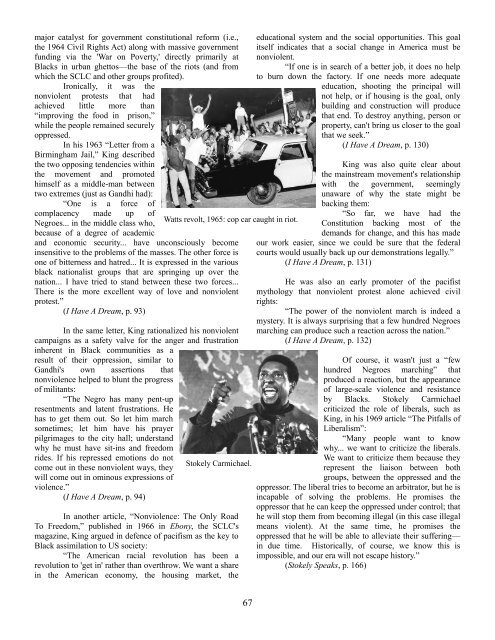smash-pacifism-zine
smash-pacifism-zine
smash-pacifism-zine
You also want an ePaper? Increase the reach of your titles
YUMPU automatically turns print PDFs into web optimized ePapers that Google loves.
major catalyst for government constitutional reform (i.e.,<br />
the 1964 Civil Rights Act) along with massive government<br />
funding via the 'War on Poverty,' directly primarily at<br />
Blacks in urban ghettos—the base of the riots (and from<br />
which the SCLC and other groups profited).<br />
Ironically, it was the<br />
nonviolent protests that had<br />
achieved little more than<br />
“improving the food in prison,”<br />
while the people remained securely<br />
oppressed.<br />
In his 1963 “Letter from a<br />
Birmingham Jail,” King described<br />
the two opposing tendencies within<br />
the movement and promoted<br />
himself as a middle-man between<br />
two extremes (just as Gandhi had):<br />
“One is a force of<br />
complacency made up of<br />
Negroes... in the middle class who,<br />
because of a degree of academic<br />
and economic security... have unconsciously become<br />
insensitive to the problems of the masses. The other force is<br />
one of bitterness and hatred... It is expressed in the various<br />
black nationalist groups that are springing up over the<br />
nation... I have tried to stand between these two forces...<br />
There is the more excellent way of love and nonviolent<br />
protest.”<br />
(I Have A Dream, p. 93)<br />
Watts revolt, 1965: cop car caught in riot.<br />
In the same letter, King rationalized his nonviolent<br />
campaigns as a safety valve for the anger and frustration<br />
inherent in Black communities as a<br />
result of their oppression, similar to<br />
Gandhi's own assertions that<br />
nonviolence helped to blunt the progress<br />
of militants:<br />
“The Negro has many pent-up<br />
resentments and latent frustrations. He<br />
has to get them out. So let him march<br />
sometimes; let him have his prayer<br />
pilgrimages to the city hall; understand<br />
why he must have sit-ins and freedom<br />
rides. If his repressed emotions do not<br />
Stokely Carmichael.<br />
come out in these nonviolent ways, they<br />
will come out in ominous expressions of<br />
violence.”<br />
(I Have A Dream, p. 94)<br />
In another article, “Nonviolence: The Only Road<br />
To Freedom,” published in 1966 in Ebony, the SCLC's<br />
maga<strong>zine</strong>, King argued in defence of <strong>pacifism</strong> as the key to<br />
Black assimilation to US society:<br />
“The American racial revolution has been a<br />
revolution to 'get in' rather than overthrow. We want a share<br />
in the American economy, the housing market, the<br />
educational system and the social opportunities. This goal<br />
itself indicates that a social change in America must be<br />
nonviolent.<br />
“If one is in search of a better job, it does no help<br />
to burn down the factory. If one needs more adequate<br />
education, shooting the principal will<br />
not help, or if housing is the goal, only<br />
building and construction will produce<br />
that end. To destroy anything, person or<br />
property, can't bring us closer to the goal<br />
that we seek.”<br />
(I Have A Dream, p. 130)<br />
King was also quite clear about<br />
the mainstream movement's relationship<br />
with the government, seemingly<br />
unaware of why the state might be<br />
backing them:<br />
“So far, we have had the<br />
Constitution backing most of the<br />
demands for change, and this has made<br />
our work easier, since we could be sure that the federal<br />
courts would usually back up our demonstrations legally.”<br />
(I Have A Dream, p. 131)<br />
He was also an early promoter of the pacifist<br />
mythology that nonviolent protest alone achieved civil<br />
rights:<br />
“The power of the nonviolent march is indeed a<br />
mystery. It is always surprising that a few hundred Negroes<br />
marching can produce such a reaction across the nation.”<br />
(I Have A Dream, p. 132)<br />
Of course, it wasn't just a “few<br />
hundred Negroes marching” that<br />
produced a reaction, but the appearance<br />
of large-scale violence and resistance<br />
by Blacks. Stokely Carmichael<br />
criticized the role of liberals, such as<br />
King, in his 1969 article “The Pitfalls of<br />
Liberalism”:<br />
“Many people want to know<br />
why... we want to criticize the liberals.<br />
We want to criticize them because they<br />
represent the liaison between both<br />
groups, between the oppressed and the<br />
oppressor. The liberal tries to become an arbitrator, but he is<br />
incapable of solving the problems. He promises the<br />
oppressor that he can keep the oppressed under control; that<br />
he will stop them from becoming illegal (in this case illegal<br />
means violent). At the same time, he promises the<br />
oppressed that he will be able to alleviate their suffering—<br />
in due time. Historically, of course, we know this is<br />
impossible, and our era will not escape history.”<br />
(Stokely Speaks, p. 166)<br />
67



